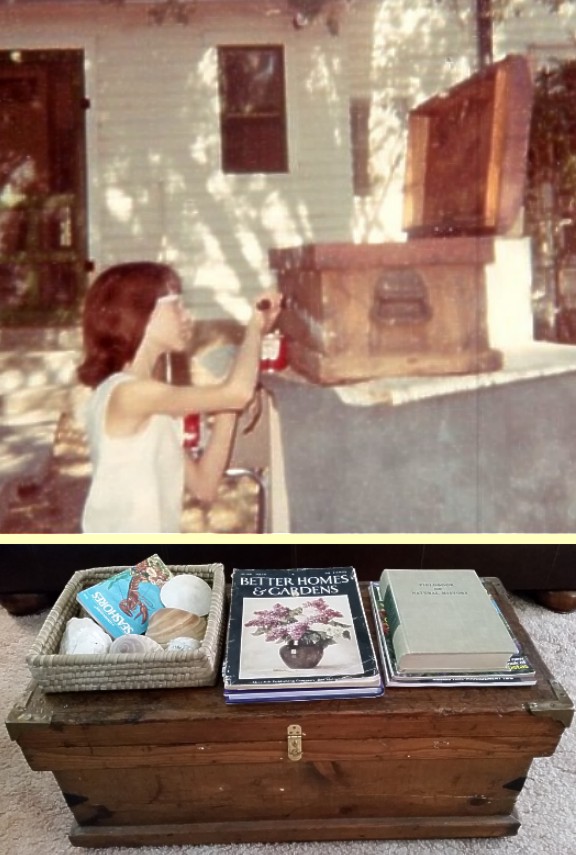
Above, 1968 photo of Gloria working on her hopeful chest; bottom: chest today.
Comments? [email protected].
Earlier columns from 2016 may be found at: 2016 Index.
Links to previous years are on the home page: Home
Kansas Snapshots by Gloria Freeland - June 17, 2016
Hopeful chests
June is often considered the month of weddings. In my own family, sister Gaila and husband Humberto married in June as did nephew Michael and wife Kristina. Weddings often have traditions associated with them and some of those, such as the bride wearing "something old, something new, something borrowed, something blue" continue.
But others have all but disappeared. One I remember from my growing-up years was the tradition of having a "hope chest" - a small trunk or chest to collect items with the hope of using them after getting married.
But when I asked daughter Katie if she knew what a hope chest was, she just gave me a puzzled look.
According to Wikipedia, hope chests were an ancient tradition to prepare a girl for her future as a wife. They were also known by other names, like glory boxes, dowry chests, trousseau chests and cedar chests.
The contents of a traditional hope chest included linen, towels, silverware, family heirlooms, dishes and candlesticks. In Medieval Europe, a man was expected to provide land to his wife-to-be's family. In return, the bride's family provided her with items of daily necessity as a dowry. Poorer families taught their daughters skills such as sewing, knitting, crocheting and embroidery. The father usually built her a wooden chest that he decorated. A girl could then stock this chest with items she had made herself or had received as gifts.
I had two hope chests, but the first certainly did not begin as one. Grandpa Nels Mostrom's old toolbox found a lot of service on his Morris County, Kansas farm. It was dirty, well-worn and somewhat greasy when I claimed it. I was an ambitious 4-H Club member, and "Home Improvement" was one of my projects. I was determined to turn it into a thing of beauty.
First, I cleaned the chest and let it dry. Then, thinking that spray paint was a good idea, I painted it gold inside and out. For the top, I took a scrap of the red carpet and carpet padding that had been used on Gaila's and my bedroom floor and fastened them with gold braid and brads tacked around the edges. The idea was to use the chest not only for storage, but as a window seat.
The finished product was not the thing of beauty I had hoped for. But I still recall putting some of Grandma Ethel Freeland's hand-embroidered tea towels, a few pieces of Grandma Hulda Mostrom's crochet work, several of Grandpa Mostrom's loop potholders, a few pieces of silverware and who knows what else, inside. I jokingly called it my "hopeful chest" - or at least I told others it was a joke.
About 10-15 years ago, I ripped off the carpet and pad, had the gold paint removed and had new hinges and a fastener added. I now use the chest as a coffee table in our living room, and I store silk Christmas greenery inside. I'm sure Joanna Gaines of HGTV's "Fixer Upper" show would approve because the chest has just enough nicks and "patina" to give it personality.
The other hope chest in my life is a Lane Cedar Chest given by my folks to husband Art and me when we were married in July 1988. A small wooden plaque on the inside says: "With Love on Your wedding happiness Mom and Dad." Art and I use it to store wool sweaters and other clothing items.
I did some Internet research and found that The Lane Co. was once the largest manufacturer of hope chests in the U.S., having produced 12 million of them between 1912 and 1987. When World War I began, the Virginia-based company received a contract from the government to manufacture pine chests to store military ammunition. After the war, the company diversified its operations to produce cedar boxes for domestic use, which helped revive the custom of having hope chests. During the 1930s, the company offered free miniature hope chests to girls graduating from high school to entice them to buy the larger versions. During World War II, the company persuaded American G.I.s to buy the chests for their wives or girlfriends. But after the war, the tradition again faded.
When I mentioned I was researching hope chests, Art reminded me that his mother Donna's is still in the upstairs bedroom of the home his brother now owns. For years, Donna used it to store extra blankets for their beds. Donna often said after her death, she wanted the chest to go to Art's daughter Karen. But it is still where it was because it is so big and quite old fashioned. Art said he always kidded his mother it was called a hope chest because so many women wished it would bring them a chest - and not the kind you put blankets in.
As with Katie, I doubt most young girls today even know what they are. Still, mine bring back happy and hopeful memories of my younger days.

Above, 1968 photo of Gloria working on her hopeful chest; bottom: chest today.
Comments? [email protected].
Earlier columns from 2016 may be found at: 2016 Index.
Links to previous years are on the home page: Home